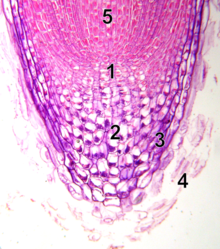Plant stem cell
This article has multiple issues. Please help improve it or discuss these issues on the talk page. (Learn how and when to remove these template messages)
|

Plant stem cells
Plant stem cells are innately
Plant stem cells are characterized by two distinctive properties, which are: the ability to create all
Unlike animals, plants are immobile. As plants cannot escape from danger by taking motion, they need a special mechanism to withstand various and sometimes unforeseen
Plant stem cells are also characterized by their location in specialized structures called meristematic tissues, which are located in
Research and development
Traditionally, plant stem cells were thought to only exist in SAM and RAM and studies were conducted based on this assumption. However, recent studies have indicated that (pro)cambium also serves as a niche for plant stem cells: "Procambium cells fulfill the criteria for being stem cells since they have the capacity for long-term self renewal and being able to differentiate into one or more specialized cell types."[6][failed verification]
Cambium is a type of meristem with thin walls which minutely exist in small populations within a plant. Due to this structural characteristic, once physical force is applied to it, it is easily damaged in the very process of isolation, losing its stem cell characteristics. Despite 160 years of biological effort to isolate and retrieve plant stem cells, none succeeded in the isolation due to the distinct structural characteristics of plant stem cell: "[t]he cambium consists of a few layers of narrow elongated, thin-walled cells, easily damaged during sampling." This highly vulnerable feature has made studies on cambial structure and ultrastructure difficult to achieve with conventional methods. Thus failure to isolate plant stem cells from meristematic tissues prompted scientists to administer plant cell culture by using callus (dedifferentiated cells) as an alternative to plant stem cells.
Callus, or dedifferentiated cells, are
Plant stem cell vs. callus
Despite that callus exhibits a number of stem cell-like properties for a temporary period and that it has been cultured for useful plant compounds as an alternative source of plant stem cell, callus and plant stem cell are fundamentally different from each other. Callus is similar to plant stem cell in its ability to differentiate, but the two are different in their origin. While plant stem cell exists in the meristematic tissues of plant, callus is obtained as a temporary response to cure wounds in somatic cell.
Moreover, callus undergoes dedifferentiation as differentiated cells acquire ability to differentiate; but
Furthermore, the ability to differentiate and proliferate is different that differences between plant stem cell and callus are prevalent in culture and research. Only plant stem cells embedded in meristems can divide and give rise to cells that differentiate while giving rise to new stem cells. These immortal cells divide infinitely.
Bioprocess innovation
Plant cells are cultured to acquire plant useful compounds. However cell cultures are often hindered by various factors especially if cell culture continues long-term. However, strong vitality and structural characteristics of plant stem cell overcome previous drawbacks to plant cell culture. Thus plant stem cell culture is the most ideal and productive method of cell culture and phytochemical production as cells are successfully mass cultured while maintaining quality.
Further applications
Numerous medicines, perfumes, pigments, antimicrobials, and insecticides are derived from plant natural products. Cultured Cambial Meristematic Cells (CMC) may provide a cost-effective, environmentally friendly, and sustainable source of important natural products, including paclitaxel. Unlike plant cultivation, this approach is not subject to the unpredictability caused by variation in climatic conditions or political instability in certain parts of the world. Also, CMCs from reference specifies may also provide an important biological tool to explore plant stem cell function.
In 2010, researchers from the Plant Stem Cell Institute (formerly Unhwa Institute of Science and Technology) presented their data to the world via Nature Biotechnology. Their research demonstrated the world's first cambial meristematic cell isolation. Due to the valuable and beneficial compounds for human health (i.e. paclitaxel) which are secreted by the CMC's, this technology is considered a serious breakthrough in plant biotechnology.[7][non-primary source needed]
See also
References
Further reading
- Singh MB, Bhalla PL (May 2006). "Plant stem cells carve their own niche". Trends in Plant Science. 11 (5): 241–6. PMID 16616580.
- Weigel D, Jürgens G (February 2002). "Stem cells that make stems". Nature. 415 (6873): 751–4. S2CID 9032410.
- Ivanov VB (October 2007). "Oxidative stress and formation and maintenance of root stem cells". Biochemistry. Biokhimiia. 72 (10): 1110–4. S2CID 14674628.
- Müller B, Sheen J (June 2008). "Cytokinin and auxin interaction in root stem-cell specification during early embryogenesis". Nature. 453 (7198): 1094–7. PMID 18463635.
- Neumüller RA, Betschinger J, Fischer A, Bushati N, Poernbacher I, Mechtler K, Cohen SM, Knoblich JA (July 2008). "Mei-P26 regulates microRNAs and cell growth in the Drosophila ovarian stem cell lineage". Nature. 454 (7201): 241–5. PMID 18528333.
- Scheres B (May 2007). "Stem-cell niches: nursery rhymes across kingdoms". Nature Reviews. Molecular Cell Biology. 8 (5): 345–54. S2CID 34588810.
- Eric, Simon; Campbell, Neil; Reece, Jane (2007). Essential Biology with Physiology. San Francisco, CA: Pearson Benjamin Cummins. ISBN 9780805368413.
- Staveley BE (10 December 2008). "Plant Development". Department of Biology. Memorial University of Newfoundland. Archived from the original on 30 November 2012. Retrieved 8 September 2017.
